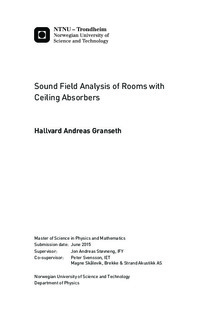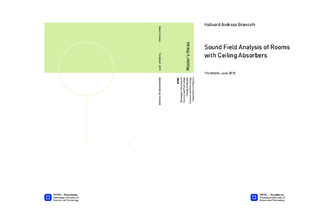| dc.contributor.advisor | Støvneng, Jon Andreas | |
| dc.contributor.advisor | Svensson, Peter | |
| dc.contributor.advisor | Skålevik, Magne | |
| dc.contributor.author | Granseth, Hallvard Andreas | |
| dc.date.accessioned | 2015-11-11T15:00:33Z | |
| dc.date.available | 2015-11-11T15:00:33Z | |
| dc.date.created | 2015-06-27 | |
| dc.date.issued | 2015 | |
| dc.identifier | ntnudaim:13879 | |
| dc.identifier.uri | http://hdl.handle.net/11250/2360127 | |
| dc.description.abstract | The theory on damped modes and absorption of modes with grazing incidence presented by Kinsler et al. has been applied to the shoebox-shaped room with five hard walls and one absorber wall, using measurements in a scale model box. Single mode reverberation time analysis, estimations of reverberation time based on grazing mode absorption via measurements of the specific acoustic impedance, and measurements of vertical components of the sound intensity has all been used in an attempt at identifying grazing modes and comparing the theoretical descriptions to the observed sound field.
The thesis found Kinsler et al.'s theory on damped modes and absorption of modes with grazing incidence to be poorly suited for the shoebox-shaped room with five hard walls and one absorber wall. Grazing modes and non-grazing modes were not separable, neither by reverberation time estimates nor by sound intensity measurements. The reverberation time estimates using the damped modes & grazing mode absorption theory were several orders of magnitude less than the observed reverberation time. The most likely weakness in the theory is thought to be the assumption on wall impedance, which does not fit with porous absorbers on rigid walls. | |
| dc.language | eng | |
| dc.publisher | NTNU | |
| dc.subject | Fysikk og matematikk, Teknisk fysikk | |
| dc.title | Sound Field Analysis of Rooms with Ceiling Absorbers | |
| dc.type | Master thesis | |
| dc.source.pagenumber | 120 | |

